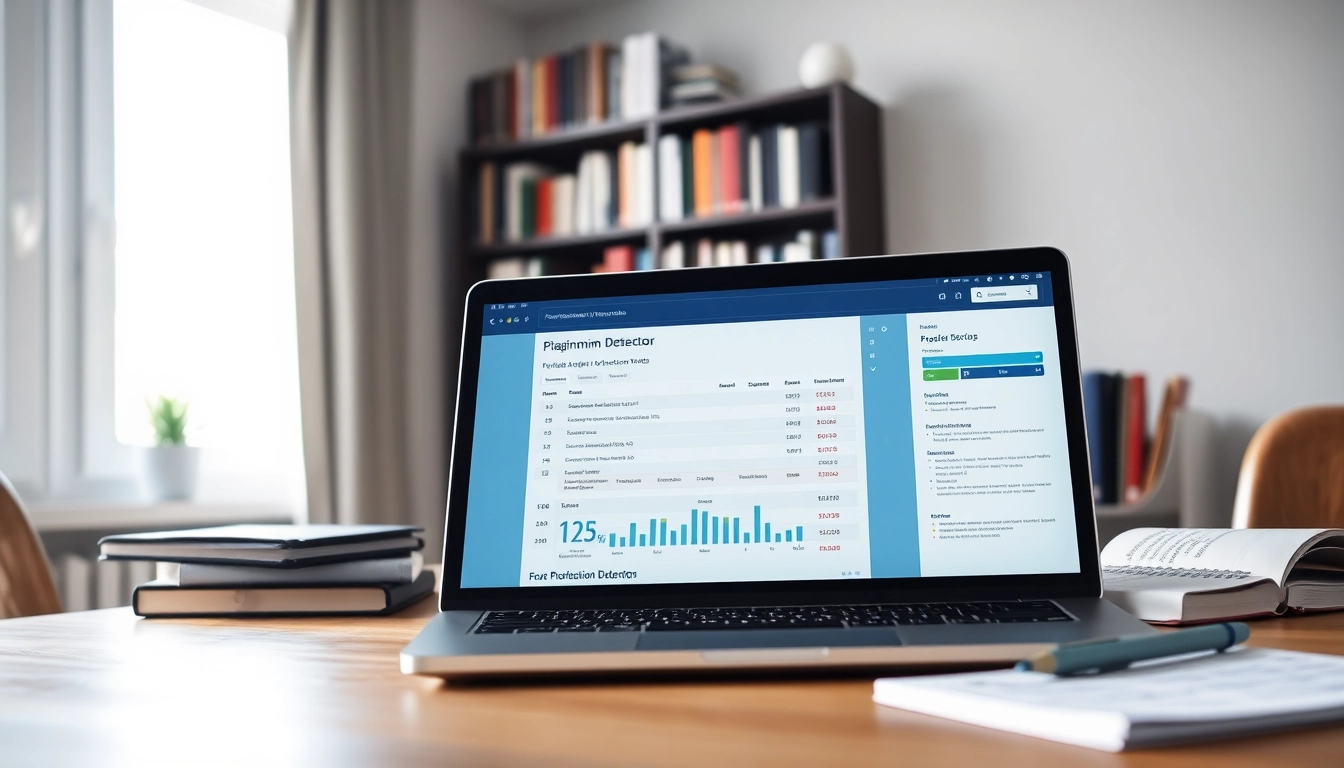
Understanding Plagiarism Detection
What is a Plagiarism Detector?
A plagiarism detector is a software or online tool designed to identify instances of plagiarism in written content. This technology scans text against a vast database of online resources, academic papers, and other written work to determine the originality of the submitted document. When someone submits a piece of writing, the detector analyzes it for similarities to existing works and produces a report indicating the percentage of text that is potentially plagiarized.
How Plagiarism Detectors Work
Plagiarism detectors use algorithms and databases to compare submitted content with other texts. The process typically involves several key steps:
- Text Submission: Users upload their documents into the plagiarism detection tool.
- Data Comparison: The system scans the submitted text and compares it with its internal database, which may contain billions of web pages, academic articles, and previous submissions.
- Analysis: The software analyzes the content to identify patterns, phrases, and citations that match existing texts.
- Reporting: After completing the analysis, the tool generates a report detailing the number of matched sources, the percentage of similarity, and, in some cases, recommendations for correcting plagiarized sections.
Many advanced plagiarism checkers also employ artificial intelligence (AI) to improve their accuracy and detection capabilities, making them invaluable tools for educators, students, and writers. For instance, integrating a robust plagiarism detector into the writing process can enhance the originality and credibility of the content.
Importance of Academic Integrity
Academic integrity is a cornerstone of educational institutions worldwide. Plagiarism undermines the value of education and devalues students’ learning experiences. By using plagiarism detectors, both educators and students can uphold academic integrity. These tools not only detect copied content but also serve as educational resources, guiding users to understand proper citation practices and the ethical implications of plagiarism.
Institutions emphasize the importance of originality in student work, as it reflects a student’s understanding and mastery of the subject matter. Additionally, academic dishonesty can lead to severe consequences, including failing grades, academic probation, or even expulsion. By adopting plagiarism detection methods, students can ensure their submissions are genuine and reflective of their own thoughts and efforts.
Key Features of a Reliable Plagiarism Detector
Accuracy and Speed of Detection
One of the primary requirements for a plagiarism detector is its accuracy. The ability to precisely identify matching phrases while minimizing false positives is crucial. Users rely on these tools to provide a clear understanding of how much of their text is original versus duplicated. A reliable plagiarism detector should deliver quick results, ideally within minutes, accommodating the user’s availability and time constraints.
Some advanced tools can process large documents with thousands of words swiftly while maintaining accuracy. Look for detectors that regularly update their databases to include new content available online, ensuring comprehensive scans that reflect the latest material.
User-Friendly Interface
An intuitive and user-friendly interface is essential for any plagiarism detection tool. Users range from experienced academics to students unfamiliar with technology, so the platform should cater to various experience levels. Key features should include:
- Simple Navigation: The platform should allow users to easily navigate between document uploading, reports, and settings.
- Clear Reporting: Results should be straightforward and presented in an easy-to-understand format, ideally with visual aids such as charts or percentage indicators.
- Support and Resources: Access to support materials, tutorials, and FAQs can help users understand the features and interpretations of the reports better.
Support for Multiple Document Formats
As individuals utilize various writing platforms, it is crucial for a plagiarism detector to support multiple document formats. Reliable tools allow users to upload files in formats such as:
- DOC and DOCX (Microsoft Word files)
- PDF (Portable Document Format)
- TXT (plain text files)
- RTF (Rich Text Format)
- HTML (HyperText Markup Language)
This versatility allows users to seamlessly integrate plagiarism checking into their workflow, regardless of the software they use to create their documents.
Comparing Popular Plagiarism Detectors
Grammarly vs. DupliChecker
Grammarly is widely known for its grammar checking capabilities but also offers a robust plagiarism detection feature. It compares text against billions of web pages and academic publications, providing detailed reports. DupliChecker, on the other hand, is a dedicated plagiarism checking tool that offers its services for free with certain limitations, such as file size and daily usage. Both tools recognize plagiarism but cater to different user needs.
Grammarly’s premium service includes advanced features like tone suggestions, vocabulary enhancements, and plagiarism detection, making it an all-in-one writing assistant. DupliChecker, while effective, lacks additional writing aids, making it ideal for users solely focused on plagiarism detection. Ultimately, the choice depends on whether users prioritize a comprehensive writing assistant or a specialized plagiarism-checking tool.
Scribbr vs. Copyleaks
Scribbr is an academic-focused plagiarism detection tool used primarily by students and researchers. It boasts an extensive database, allowing it to detect even subtle forms of plagiarism effectively. The reports provided by Scribbr are detailed and easy to understand, showcasing similarities in a user-friendly format. Copyleaks, on the other hand, targets both academic and business audiences, allowing users to check the originality of coding and content alike.
For academic purposes, Scribbr is often favored due to its specific focus, while businesses might prefer Copyleaks for its versatility. Both tools incorporate AI technology to enhance detection accuracy, making them leaders in their respective niches.
Free vs. Paid Plagiarism Detectors
When choosing a plagiarism detection tool, users frequently grapple with the decision between free and paid options. Free tools generally offer basic features that may suffice for simple checks. However, they often come with limitations, such as restricted search capabilities, limited document size, or lower accuracy rates.
Conversely, paid plagiarism detectors typically provide more comprehensive services, such as deeper database access, faster results, and detailed reports. These services often integrate sophisticated algorithms, ensuring higher accuracy and improved detection of paraphrased materials and AI-generated text. Purchasing a subscription or one-time service can be considered a worthwhile investment for freelancers, students, and academics looking for quality assurance in their writing.
Best Practices for Using a Plagiarism Detector
How to Prepare Your Document
Before submitting a document for plagiarism detection, users should consider several preparatory steps:
- Proofreading: Ensure the text is free from grammatical errors and typos. Carefully edited documents yield more accurate plagiarism detection results.
- Format Consistency: Standardize the document format according to the requirements of the selected plagiarism detector. This ensures smooth uploading and processing.
- Screen for Common Knowledge: Authors should avoid submitting documents with widely accepted phrases or facts that do not require citations; such elements might skew originality reports.
Interpreting Detection Reports
Understanding the results of a plagiarism detection report is essential for users to take appropriate actions. Most reports categorize matches based on severity, highlighting areas of concern and providing links to potential source materials. Here are a few tips for interpreting these reports effectively:
- Threshold Analysis: Look at the overall similarity percentage and set individual thresholds based on context and requirements.
- Assess Matches: Review identified passages carefully. Some may be legitimate quotes or sources that require appropriate citation.
- Improvement Recommendations: Use the tool’s suggestions to improve originality, such as rephrasing detected passages or adding citations.
Steps to Avoid Plagiarism
To prevent inadvertent plagiarism, writers can adopt several best practices throughout their writing process:
- Proper Citations: Always cite sources accurately to give credit to original authors.
- Educational Tools: Utilize secondary resources, such as writing guides, to understand the nuances of different citation styles.
- Paraphrase Effectively: Instead of copying text, learn to rephrase ideas in your own words while maintaining the original meaning.
- Use Plagiarism Detectors: Regularly check submissions with a plagiarism detector to ensure text originality before finalizing or submitting work.
Future Trends in Plagiarism Detection Technology
AI Advancements in Plagiarism Detection
Artificial Intelligence is reshaping plagiarism detection, improving the ability of these tools to recognize not just direct copying but also indirect plagiarism, including paraphrasing and conceptual similarity. Advances in machine learning enable detectors to evolve continually, enhancing their capacity to analyze context and style during text comparison.
Furthermore, as AI technologies become more sophisticated, plagiarism detectors will likely offer more detailed insights and educational resources to help writers better understand plagiarism and originality.
Integration with Learning Management Systems
The landscape of education is changing rapidly, with many institutions relying on Learning Management Systems (LMS) to facilitate online learning. Future plagiarism detection tools may see greater integration with these systems, allowing for seamless check functionalities that educators and students can utilize directly from their course platforms.
This integration can streamline processes, providing instant feedback to students on potential plagiarism issues as they compose their assignments. Such advancements would not only support academic integrity but also enhance learning outcomes.
Personalizing Detection Strategies
As technology evolves, so will the ability to personalize plagiarism detection strategies. Future tools may incorporate user preferences, writing styles, or disciplinary guidelines, allowing customized detection approaches that align with individual user needs. This personalization could enhance user experience and provide more relevant feedback, further supporting the goal of academic integrity.








